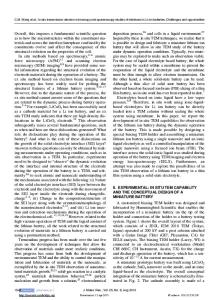On the in situ study of Li ion transport in transmission electron microscope
- PDF / 789,703 Bytes
- 5 Pages / 584.957 x 782.986 pts Page_size
- 69 Downloads / 3,898 Views
For understanding the atomic processes involved, in situ observation at near-atomic spatial resolution is needed in the studies of lithium ion battery materials. We show that the Li transport and the lithiation of carbon atoms may be triggered by the electron beam in an electron microscope, together with simultaneous real-time monitoring of electron energy-loss spectroscopy to reveal the chemical state of the species. The local electric field induced in an electrolyte particle by an electron beam acts on Li ions, resulting in Li transport and reaction with carbons. This process closely mimics the charging process of an electrochemical battery charge cycle, without an external power supply. We find that the lithium transport occurs in the form of Li1. I. INTRODUCTION
The ubiquitous lithium-ion battery (LIB) has been developed over the past four decades into the most successful portable power source now available.1,2 It offers among the best energy density, cost, performance, and safety characteristics, and so finds application in a wide range of electric vehicles, aerospace and portable electronics, and tools. Although it has been under continuous development, the underlying chemical physics of this critical technology remains poorly understood. The charge/discharge cycle of these batteries can be described as a process of intercalation and deintercalation of Li1 ions between the host material electrodes. The dynamics during electrochemical cycling and Li transport in these materials are of great importance in determining failure mechanisms and suggesting modifications for improved performance. Ex situ observations of changes in the crystal structure and chemistry have proven useful for understanding the structure and property relationships.3 However, the dynamic nature of the atomic process of electrochemical cycling requires in situ methods with the ability to image atomic transport directly, as well as chemical reactions at the nanometer scale. Previous in situ studies have mainly used x-ray4 and neutron5 probes. Recently, there have been several in situ transmission electron microscopy (TEM) studies on LIBs.6–20 This technique, combined with x-ray spectroscopy and/or electron energy-loss spectroscopy (EELS), has the unique merit of directly imaging and analyzing the electrochemical process and the chemical state of the ions, with a subnanometer spatial resolution, in real time. However, the current techniques for in situ TEM studies of lithiation and a)
Address all correspondence to this author. e-mail: [email protected] DOI: 10.1557/jmr.2014.355 424
J. Mater. Res., Vol. 30, No. 3, Feb 14, 2015
http://journals.cambridge.org
Downloaded: 18 Feb 2015
delithiation processes require a specialized TEM holder, in which a LIB cell is set up. The materials suitable for making a TEM LIB cell are limited. For general interest, it is necessary to develop an inexpensive and easily applied approach, which allows observation of the electrochemical reaction in real time. Recently, we have discovered that the electron beam its
Data Loading...











